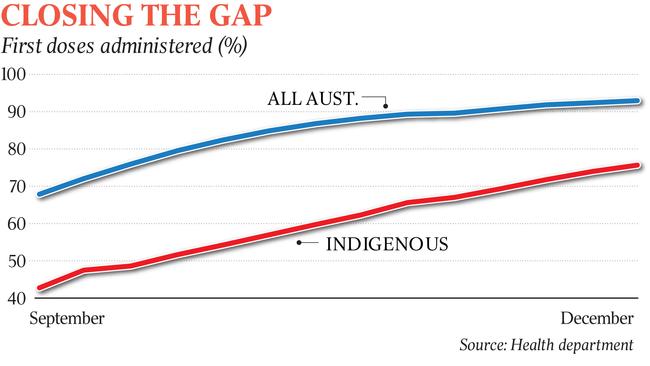Vaccine rollout targets Indigenous children to protect their communities
Health officials say vaccinating Indigenous pre-teens will limit social and health harm of outbreaks in remote communities.

One-third of eligible Indigenous Australians aged under 30 are yet to receive a Covid-19 vaccine, as health services try to overcome widespread hesitancy and complacency among young people.
With the technical advisory group on immunisation recommending the Pfizer vaccine for five to 11-year-olds, health officials say vaccinating Indigenous pre-teens would significantly limit the social and health harm of outbreaks in remote communities.
So far, two-thirds of Indigenous people under the age of 30 have received a Covid-19 vaccine, compared to 84 per cent for the entire cohort of six million people.
Chief executive of the National Aboriginal community Controlled Health Organisation Pat Turner told The Weekend Australian there had been some variation in vaccine coverage across jurisdictions and age groups.
“In places where there have been very few cases of Covid-19 or where the perceived risk of illness is lower, such as younger people, there is more complacency and not the same sense of urgency,” Ms Turner said. “Vaccine hesitancy mainly caused by misinformation or religious messaging has also impacted vaccine uptake in some communities.”
On Friday, the co-ordinator-general of the national Covid vaccine rollout, Lieutenant General John Frewen, provided an update to national cabinet on the plans to close the gap in vaccination rates between Aboriginal and Torres Strait Islander Australians and the general population.
Although Indigenous vaccination rates still lag the Australian average by between 17 and 23 percentage points, on first and second doses respectively, the gap has been closing over the past six weeks, aided by an acceleration program in 30 local government areas around the country.
Ms Turner said the vaccination rate convergence was a positive development.
“We have seen a lot of success using community engagement activities such as Vaxathons,” she said.
“This has been particularly prominent across the Kimberley region, where in some communities more than 90 per cent of those eligible are fully vaccinated.

“In other regions, we have seen success with door-to-door vaccinations. Many services have employed community engagement officers to start conversations.
“Having trusted people in the community provide the community with the information helps people make an informed decision. Once people have had the opportunity to have the conversation, they are much more comfortable to get the vaccine and understand the importance.”
Health officials believe the decision to open up vaccinations to more children will pay dividends in Indigenous communities, where five to 11-year-olds make up 15 per cent of the population, compared with 9 per cent in the non-Indigenous population.
This week, the co-chair of the Aboriginal and Torres Strait Islander Advisory Group on Covid-19, Lucas de Toca, said modelling by the Doherty Institute and others underpinning national cabinet’s reopening plan for First Nations showed vaccinating younger children would make a big difference in stopping the spread of the virus.
The senior federal health official told the Senate’s Covid-19 committee the research showed that intrinsic health conditions in remote communities, including the number of people living in the same household, increased the transmission potential of the virus if it took hold in the community,
“Vaccination of the five to 11-year-old population will make a significant difference in bringing down the reproductive number for the virus to under one, thus helping control outbreaks,” Dr de Toca said.
Potentially, this would occur “without more significant public health and social measures like what we are currently seeing in some of the excellent responses to the Northern Territory outbreak and others”.
“So, there is a very significant impact in First Nations communities,” he said.
Indigenous children have a 97 per cent paediatric vaccination rate, compared with 95 per cent for all Australian five-year-olds.




To join the conversation, please log in. Don't have an account? Register
Join the conversation, you are commenting as Logout